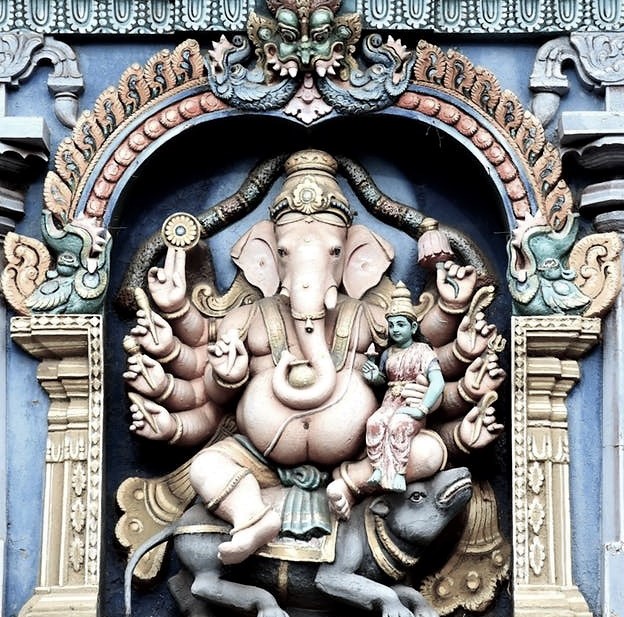- Special FeaturesFoundation YearKalinga Emperors in Ancient Period, Basupraharaj in Medieval period in 17th century and Tara Tarini Development Board at presentSthala TreeTheerthamRathamArchitectureKalinga ArchitectureOther SpecialityBody Part: Breast/Sthan, (Adi Shakthipeeth)
- Sthala Puran
According to the Puranas, the origin of Maa Tara Tarini is directly attributed to Daksha Prajapati’s Jagna in Satya Yuga. The famous Shakta Peethas of Bimala, Tara-Tarini, Dakshina Kalika, and Kamakshi originated from the limbs of the divine corpse of Devi Sati. Mythological texts like the Shiva Purana, the Kalika Purana, the Devi Bhagabat attest to this fact.
It is known from the Mahabharata that before the commencement of the Mahabharata war, Lord Sri Krishna had advised Arjuna to offer a prayer for victory at Shridevi Kupa or Bhadrakali. Bhadrakali originated from the limbs of Sati like the other four major Adi Shakti Peethas, which existed during the time of the Mahabharata or around 6000 years ago. This is the oldest data/information we get to the date regarding the shrines' existence originated from the limbs of the divine corpse of Devi Sati.
According to available historical sources, the fall of the Kalingan Empire and its capital Sampa (Samapa), in the Kalinga war around 2300 years ago by Mauryan Emperor Ashoka, strengthened Buddhists' grip in this part of India. The then Sampa was hardly 7 km from Tara Tarini Hill Shrine. So, scholars believe that Tara Tarini was worshiped as the principal deity (Ista-Devi) of the mighty Kalinga Empire. After Ashoka conquered Kalinga, scholars found it a famous center of Buddhism. The region of Ganjam near the bank of river Rushikulya was an active Buddhist site, as shown from the Special Rock Edicts of Ashoka found at Jaugada at a distance of 4 km Tara-Tarini Hill Shrine. The name Tara (Buddhism), an important deity of the Mahayana Buddhist Pantheon, suggests Buddhist influence. An image of Buddha in meditation, present inside the temple's sanctum sanctorum, lends credence to this site's claim as an ancient center of the Buddhist Shakta cult.
According to Mahayana Buddhists' texts, in the initial days, the Buddhists didn’t believe in Goddesses' worship or Pratimapuja (Idol Worship). But, Mahayana's ecclesiastical texts reveal that from 1st century AD, after the fall of Kalinga, for the first time, the Mahayana Buddhists accepted the worship of Mother Goddess ‘Tara.’ So there is no doubt that the Buddhists have learned the ‘Tara’ Puja concept from this shrine. The Bouddha Tantrik texts, texts of the Vajrajani sect, and Hindu Tantrik texts also attest to these facts. Scholars believe that in the primary days, the Buddhists worshiped Taratarini, the Tantrik sect's principal seat in Hinduism at that time, as Bouddha Tara, and later on, included ‘Tara’ Tantrik deity or spouse of bodhisattva Avalokiteshvara in their belief system. Gradually this ‘Tara’ worship spread to different parts of the world.
Besides the worship of Tara by the Buddhist Tantrikas, the maritime history of Kalinga suggests the worship of Tara by the Sadhavas, merchants, and seamen before launching their sea voyage from the great seaports like Dantapura (Gopalpur), Pallur near Chilika Lake, Kalingapatna, and river Rushikulya. All these major seaports of the ancient world were very near the Tara Tarini hill shrine.
It is known from the available sources that till the 17th century, this place was out of the sight of the common man. According to a folk story, once Maa Tara Tarini appeared as two sisters in the house of Shri Basu Praharaj. He was a learned Brahmin of Kharida Vira Jagannathpur village in Ganjam District and one of the great devotees of the Mother Goddess but the child. After staying for some years, one day, the sisters suddenly disappeared from the house of Basu Praharaj. According to the villagers' account, the sisters traveled up to the Tarini Parvat/Ratnagiri and disappeared there.
Basu Praharaj searched these girls but did not find their tracings. His heart broke down with grief and pain. On that night, he saw a dream where the Tara and Tarini informed Basu Praharaj that they were not his daughters; they are the Adi Shakti, Tara, and Tarini. The goddesses ordered Basu to come out of the grief and said that the time has arrived. According to the Vedic tradition, full devotion renovates the temple on the hilltop of Tarini Parvat and establishes the deities.
After that divine direction, Basu discovered the tracings of the ancient most presence of Adi Shakti Tara Tarini on the sacred hilltop and immediately took steps to reconstruct the temple and the shrine. Since that time for its magnetism and sanctity, this Sthana Peetha (Breast Shrine) of Mata Sati became a center of faith and reverence for countless people, in search of peace, tranquility, guidance, and spiritual energy, and its fame spread like wildfire to become one of the popular religious destinations for millions of devotees.
- Architecture
- Alankar of Deity
- Prayers and BenefitsSpecial Vratas and PrayersOfferings to DeityStotras and Mantras
“Vimala Pada khandancha,
Stana khandancha Tarini (Tara Tarini),
Kamakhya Yoni khandancha,
Mukha khandancha Kalika (Kali)
Anga pratyanga sangena
Vishnu Chakra Kshate nacha……
- FestivalsChaitra Mela/Chaitra Parva/Chaitra YatraDussheraDipawaliSankrantiNavaratriAll Tuesdays of the year
- Sodasha Upcharas
- Prasadhas
- Social ActivitiesAnnadhanMarriageEar BoringHead ShaveDanaasEducation FacilitiesSocial DrivesOther Activities
- Arjita Seva
- Tags

